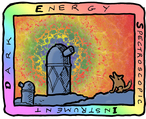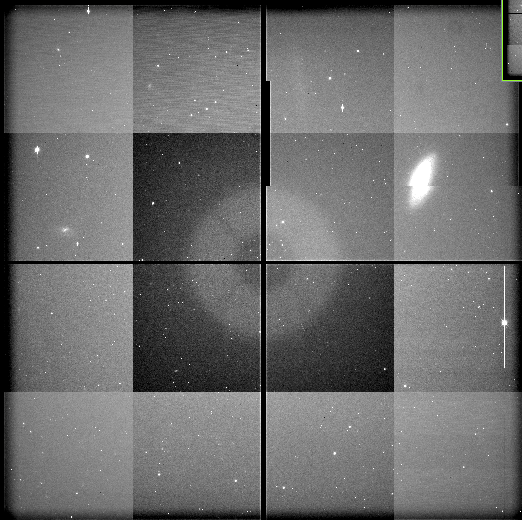| Version 39 (modified by , 10 years ago) (diff) |
|---|
Problems During Observing .. And What to Do
0. No images being written
Symptom: No new images are showing up on disk or in the obsbot display. The control system and readout timer, however, had no indication that data wasn't being written.
Frequency: This appeared as a new problem starting on 5/6 Feb 2016.
Fix:
- In a mosaic3 xterm window type
touch ~observer/exec/mosbot/quit
- Wait for the exposure to complete and the observing script to stop
- Stop NOCS using the red "Stop MOSAIC" button on the MOSAIC 3 MENU gui
- Once NOCS has shutdown, find the blue xterm window which came up when NOCS was launched and type
nocs nuke pana nocs nuke dhs nocs status all - The output from nocs status all should show that all processes are STOPPED and only 3 pvm processes RUNNING
- Restart NOCS using the blue "Start MOSAIC" button on the MOSAIC 3 MENU gui
- Once the system is back up, take a ZERO image to make sure everything is working
- When the image appears, in the IRAF window type
mscstat <file name>
- If the results of the mscstat show the noise (in the Standard Deviation column) to be 4<rms<10, then ...
- restart the observing script by following the instructions here
1. Detector timeouts
Symptom: Count-down timer in NMSL GUI turns red keeps counting down negative numbers (to -105 or so), and no new images are read.
Frequency: Several times per night in the early Feb 2016 run. No timeouts on Feb 5, one on Feb 6.
Fix:
- Stop the observing script with cntrl-C
- Restart the controllers
ditscmd nohs nohs_endobs nocs nmsl reset - Take a zero image, make sure it reads out, and check the image by running "mscstat"
- Re-start the observing script
2. Images show bad amp
Symptom: One amp has extremely large noise, looks awful the display of the image with "mcsdisplay" with a noise > 1000 ADU/pix from the "mscstat" command.
Frequency: Several times in Dec 2015 run, never in early Feb 2016 run.
Fix:
- Stop the observing script with cntrl-C
- Reset the NOCS controller by typing the following in a NOCS xterm window:
nocs reset ccp nocs init ccp
- Take two zero images. The first image is always bad. The second should be OK.
Check it using "mscstat <filename>" once it has read out. All rms values should be between 4-7 ADU except for amp 6 with will be 8-10 ADU.
- Re-start the observing script
3. 4MAPS primary mirror support goes “OFF AIR” during observing
Symptom: The OA should notice when this happens, but you can also see if the mirror support is listed as "OFF AIR" on the 4MAPS GUI. The images will also appear to have very large and strangely-shaped PSFs.
Frequency: This happened several times per night in the Dec 2015 run, but with reduced frequency in the early Feb 2016 run.
Fix:
- Stop the observing script with cntrl-C
- Wait for it to finish and for “DONE” to appear on the NMSL GUI
- Type “ditscmd nohs nohs_endobs” in the xterm window in which the script was stopped. This should readout the last image and display it on the real-time display ximtool window
- Tell the OA they can move the telescope to zenith and reset 4MAPS
- Check the last image taken when 4MAPS failure occurred - the image quality is probably bad. Add this as a bad exposure in the file ~products/mosaic3/logs/bad_expid.txt
- Once the OA has reset 4MAPS, re-start the observing script
4. Shifted images
Symptom: Sub-blocks of an image have been shifted in the readout, and is obvious on the display as the overscan region being in a different place. The readout system detects when this happens, adds a set of PIXCNT* cards in the image header, and a red line shows up on the obsbot/copilot strip chart. Every now and then, an image appears which shows a shifted region in one or more CCDs. Please log this. You can identify images with shifts by watching the copilot plots (for points with vertical red lines in the seeing plot), looking for the ERROR messages on the mosstat output, or just doing
hselect mos*fits[0] $I,pixcnt1 yes
in the IRAF window.
Frequency: A couple of times per night in the early Feb 2016 run.
Fix:
- Don't stop taking data. This one exposure will be bad, but it should recover on its own
- Add this as a bad exposure in the file ~products/mosaic3/logs/bad_expid.txt
- And add a note to the logs
5. Repeat images
Symptom: The image data is an exact duplicate of a previous image, usually the one from 6 images prior. The headers are not duplicated, only the data, although the READTIME card will be the same to all decimal places to the preceding image.
You can see whether images are repeating by typing the following command into the IRAF cl window:
hselect mos3*fits[0] $I,readtime,exptime,title yes
and look at the "readtime" column. If the numbers are the same in all decimal places and repeating, then the images are repeats. You will have to stop taking data and restart the system.
Frequency: Several times per night during the early Feb 2016 run, but should be less often now.
Fix:
- If you are running a mosbot script, stop it by going to the directory in which the script is running (~/exec/mosbot/) and
type "touch quit" and then wait for the script to end.
- use the MOSAIC startup GUI and Stop MOSAIC
- In a NOCS xterm window, type:
nocs nuke pana nocs nuke dhs
- Start MOSAIC (from the startup GUI)
- Take a zero frame and make sure all the amps are OK and have reasonable noise levels using "mscstat"
- Re-start the observing script
- List as bad exposures in the file ~products/mosaic3/logs/bad_expid.txt
6. Focus drifting
If you lose track of the focus and don’t know whether you are below or above the focus value, wait for the readout countdown to start and then type CTRL-c in the window executing the script. Wait for the readout to complete and the “DONE” to appear on the NMSL window. Then execute
ditscmd nohs nohs_endobs
Then do a focus sequence.
- Create a focus script using the “Focus” button on the NGUI This pops up the following window:
- use a good guess for the mid-point:
focus in zd filter = -8400 + (1.4C - Ttruss)*110
- an instrument focus step of -100 (or -70, if the seeing is good)
- at least 7 focus iterations and
- a detector pixel shift of 30;
- Make sure you have chosen the zd filter
- execute the focus sequence
- Edit the /data2/observer/mscfoc.cl script to change the file name of the focus image
- In the IRAF window, type "mscfoc.cl" and follow the instructions
- Once you have determined the best focus:
- set the focus value in the MCCD window and hit “Apply”
- log the Truss temperature and focus values.
- Create a new observing script
- Tell the OA that you have determined a new focus and changed the focus.
- Restart observing
7. Images of stars on the guider are bouncing around
Symptoms: Guider images are visibly bouncing around on the TV guider image, and the seeing is poor, with the image extension being primarily in the EW (i.e., up-down) direction:
Fix: If the wind is high, ask the OA to close the louvers that allow additional outside air to circulate into the dome. If observing near zenith, the lower part of the dome slit can also be closed. That lower part of the slit only starts vignetting the telescope if observing to airmasses larger than 2.
8. Bad telescope pointing
Symptoms: The reported telescope offsets from the python "obsbot" or the IDL "mosstat" show that the pointing has gone off by more than 20 arcsec. The "mosstat" script will likely fail to match stars if this offset is larger than 20 arcsec.
Frequency: This happened many times per night in 2015, but should happen only rarely now.
Fix: The operator will need to recenter the telescope. One can do this by telling the OA to offset the telescope in the *OPPOSITE* direction of the computed mosstat positional offsets, i.e., if you see:
RA, Dec offsets: -15.230 14.756
ask the OA to offset the telescope +15" in RA (i.e., east) and -15" in DEC (i.e., south) and zero the coordinates there. Only apply these offsets when the exposure is done (i.e., during readout) and when the telescope is not moving!
One can also check the observing progress using the almanac command:
IDL> almanac, 10001, /noprint
will print out a summary of all the frames from 10001 to the present in a nice tabular form (widen the window). This is useful for checking how the seeing and sky brightness have varied since frame 10001, and whether one should create and upload a new JSON observing script. The /noprint just prevents the decstat output for every frame; if you want to see that, then don't use the /noprint keyword.
Attachments (7)
-
4MAPS_gui.tiff (59.0 KB) - added by 10 years ago.
Screen shot of 4MAPS display window
-
NOCS_FOCUS.tiff (37.5 KB) - added by 10 years ago.
Image of NOCS FOCUS gui
-
4MAPS_OFF_AIR.tiff (61.7 KB) - added by 10 years ago.
4MAPS gui showing OFF AIR
-
windshake.tiff (11.8 KB) - added by 10 years ago.
Image of star with windshake
-
nocs_timeout.png (22.2 KB) - added by 10 years ago.
NOCS window timeout message
-
imageshift.png (306.4 KB) - added by 10 years ago.
example of a shifted image
- pupilghost_obscura_137456.jpg (56.1 KB) - added by 8 years ago.
Download all attachments as: .zip


